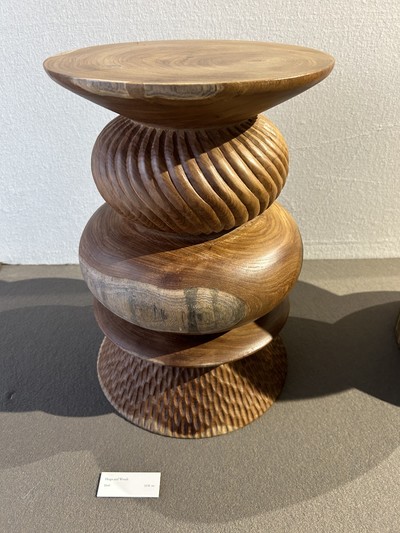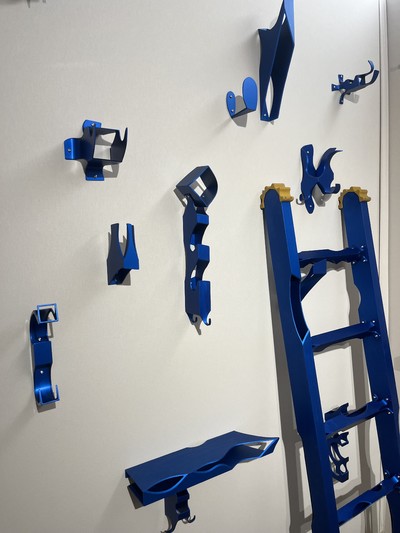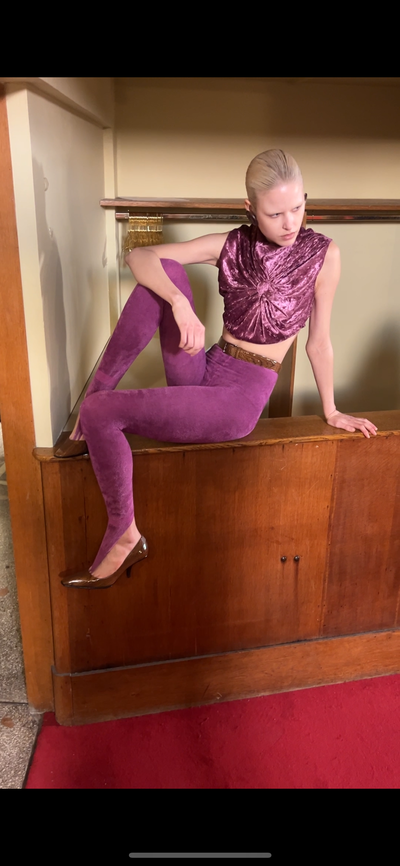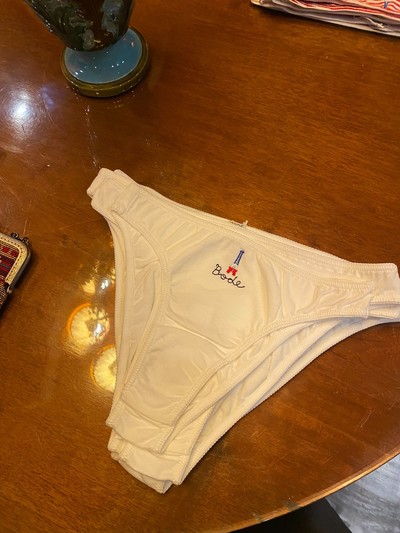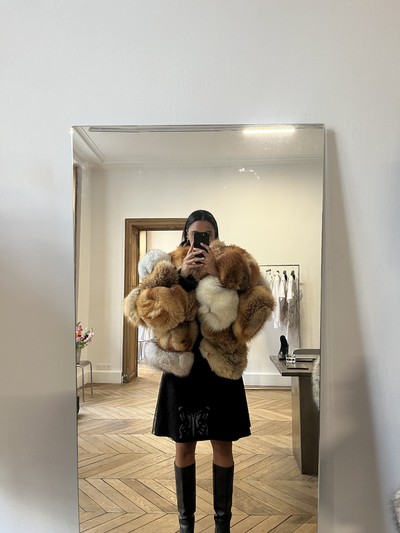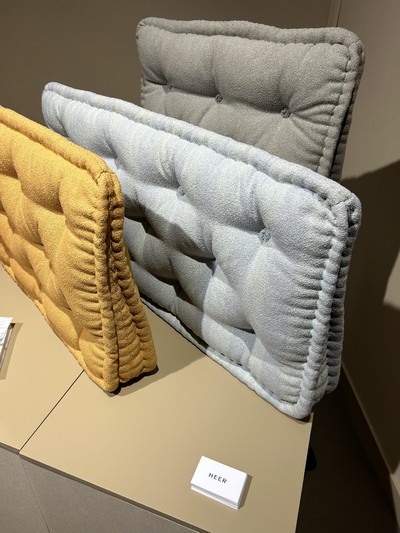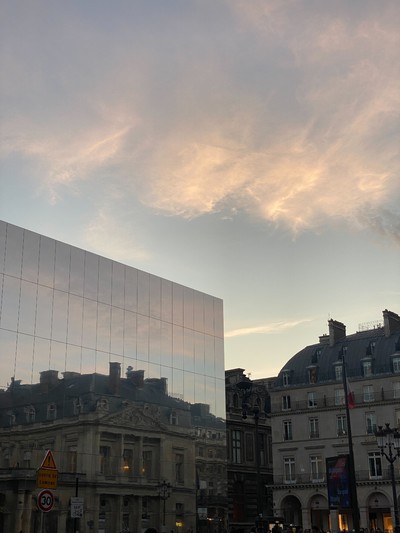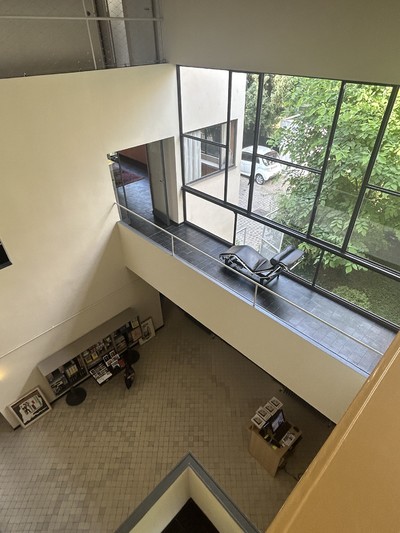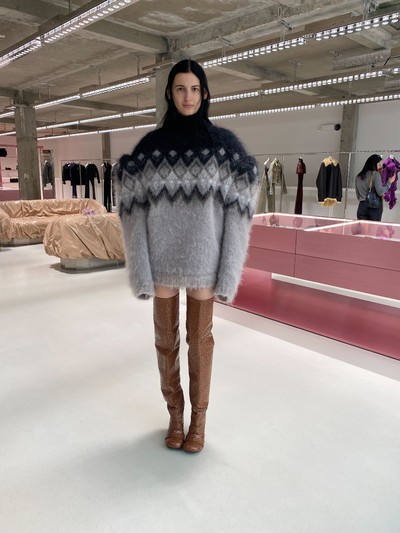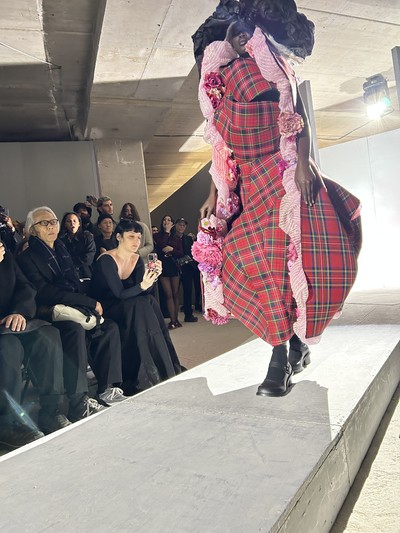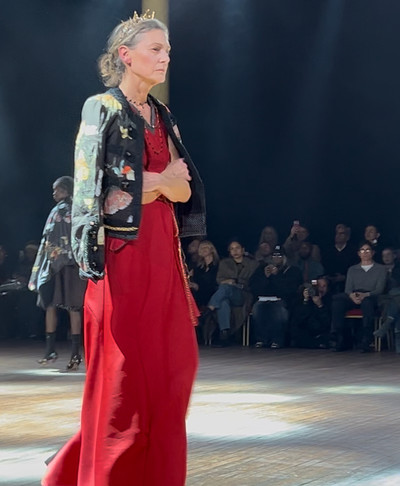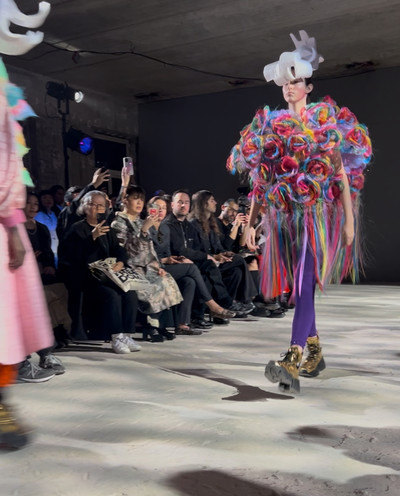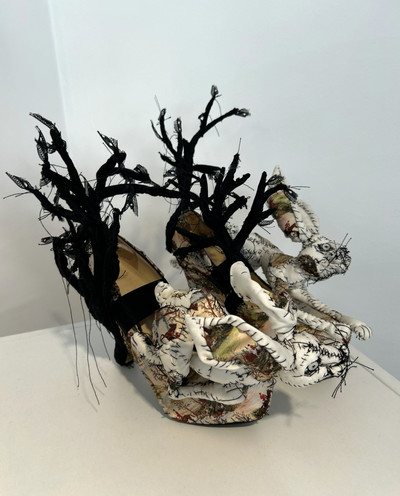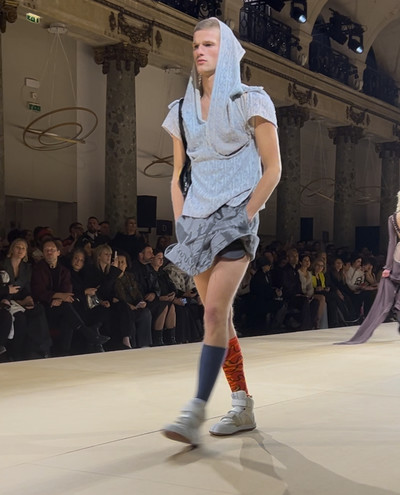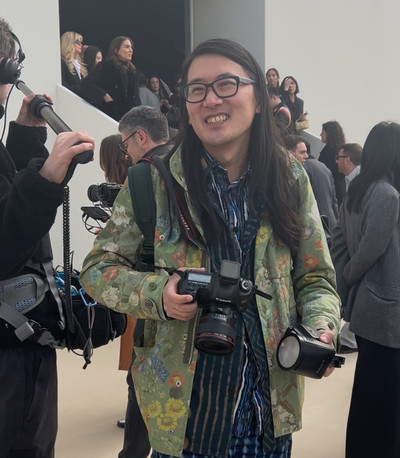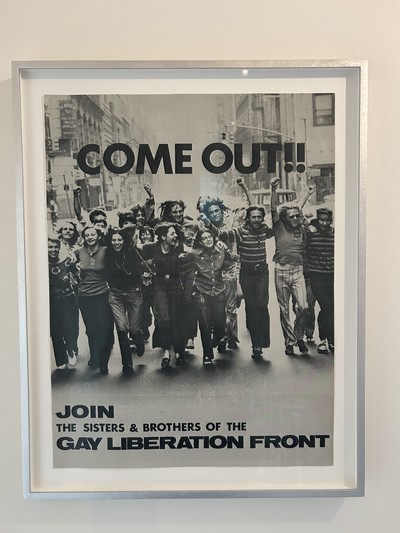Interview by Olya Kuryshchuk
‘Price points have gone up so much. Shoppers are thinking twice before spending $5,000 on a handbag. They want the reassurance that it’s not just a fleeting trend – they want to know it will carry them into the next season and beyond.’
Fashion buyers rarely speak publicly – but they shape everything we see, shop, and wear. In the following conversation, two of the sharpest and most experienced voices in the field, Judd Crane (Executive Buying & Brand Director for Selfridges) and Brigitte Chartrand (VP of Womenswear and Everything Else™ for Ssense), come together to talk frankly about what’s driving fashion today – and what’s dragging it down. Moderated by Olya Kuryshchuk, founder of 1 Granary and longtime advocate for emerging designers, the conversation moves between fashion week fatigue, the pros and cons of e-commerce and brick-and-mortar stores, AI, retail sameness, tariffs, and what buyers actually want from brands right now. A clear-eyed look at the system, from those steering it.
Olya Kuryshchuk: I would imagine the past six years for you were pretty intense, starting with Brexit, Covid, wholesale reset, tariffs, AI… Yet despite these upheavals, Ssense and Selfridges have each carved out distinct, resilient positions in the market. I’m interested in hearing your perspective on what makes your approach stand out.
Judd Crane: Well, there’s a lot to say about Selfridges. The first thing is that we see ourselves as more than a shop, as more than a retailer. We endeavour to tap into a cultural zeitgeist in new and imaginative ways, through the way we approach creativity and the design and use of our spaces. A big difference between Selfridges and Ssense is that we’re foremost a physical shop and I believe Ssense would describe itself as a digital shop. Our flagship in London is one of the top flagships in the world in terms of turnover, but I think what makes Selfridges really different from other department stores is its history. You could say that Selfridges – and Harry Gordon Selfridge, the founder – really inaugurated experiential retail. If you look back to the years when he was alive and running the store: he displayed the first airplane to ever cross the English Channel; the store also gave the first public demonstrations of televisions. As documented in Mr Selfridge, the TV show, there were lots of other pioneering details, such as putting fragrance at the entrance of the store or having themed window displays. We’re obsessed with continuing this search for great ideas. Increasingly, we see ourselves as an entertainment destination as much as a shop. We’re the first store to have a permanent cinema. We even have a skate bowl in the store. There are spaces in Selfridges that we’re dedicating to concepts that don’t necessarily bring in a lot of revenue, but we think they give our customers something exciting to engage with. It’s this that distinguishes us from other stores within the landscape of London – I think globally as well – and it pushes us to do things that are unexpected in terms of our product strategy. The way we’re approaching fashion is to push ourselves to make surprising juxtapositions between brands that you wouldn’t ordinarily see next to one another; to venture into creative areas that are beyond the commercial roadmap that one could take.
Brigitte Chartrand: On our side, what really differentiates Ssense and puts us at the forefront of online e-commerce is the approach we’ve taken to our edit and our POV. Navigating the site is simple and easy and people really love that. It’s also the combination of our cultural platform, our editorial, plus the mixture of the POV, the edit, how it’s styled, the casting direction that we have: everything put together makes us quite distinct from our competitors. I would say that remaining focused on what we do best has helped, especially during these times. People come to Ssense to discover new brands or styling ideas. That sense of discovery is what we’re continuing to focus on because when you think about our customer, which is always top of mind, we know that this is what they love the most. They become obsessed with our new arrivals page. When I’ve met some of our top clients, they know the latest product that was uploaded the previous day. Also, like every great brand that’s doing well right now, stability and leadership also helps.
‘Branding has become subtler – like Marine Serre’s moon, Margiela’s stitching, Prada’s triangle – but we still sell an awful lot of product with blatant logos.’
What is your relationship with the runway shows? At the moment, do you prioritize physical attendance?
Brigitte: Things have really changed for me since Covid. I’ve moved to Los Angeles, which is a lot further from Europe, and even going to New York feels like taking an international flight. So I have taken a bit of a step back. I’ve limited my travel and try to focus mainly on Paris. Prior to Covid, the idea of missing any of the fashion weeks would probably have given me FOMO, but I think it helped us focus on our families, which is what I’m doing: I’m focusing on my son. All of the shows are on our phones now, so I’m always on Vogue Runway looking at all of the uploads. The shows that I miss, I try to see them in showrooms, at least, so that we see the product in person. But I think connecting to other people that do the same thing as us, like seeing Judd and talking about a few things, is also very important. Do we have to be at every single show though? No, and I think we have to also give opportunities to our team members to attend some shows.
Judd: Brigitte, as you were telling that story, I suddenly remembered: one time, neither of us were in London and there was a certain Burberry show. I believe we started texting one another while I was in a parking lot in upstate New York. We were both looking at the pictures immediately as they were posted on vogue.com! But I think within that story is a key point: even if we’re not physically in a place, we’re conscious of what’s going on and paying attention to the creative direction of the shows. I have also relaxed a little bit in the last couple of seasons in terms of how many fashion weeks I attend, leaving it to the team to cover in some cases. I think that also speaks to the power of Paris Fashion Week. It has become the dominant fashion week, even more now than it was 10 years ago. It’s hard to make a trip all the way to New York or even Milan just for a few shows when we’ve got so many other work pressures or personal responsibilities. I was just in Milan last week for Salone del Mobile, and was struck by the amount of press there too. People are saying that design week has become so much more important than Milan Fashion Week, and it made me think a lot about all the fashion brands that are doing impressive presentations as part of – and maybe spending even more money on – design week. Maybe there’s a little bit of a shift away from the status quo in terms of the way brands want to express themselves.
What’s your criteria when you go to fashion week? How do you filter through the noise and choose brands or collections that are most relevant to your stores?
Judd: There’s two things. One is that there’s a finite size of display space or open-to-buy budgets. There’s also a finite amount of time, not only for us as individuals, but that our teams can spend in market looking at things to make selections. There are so many brands out there. I think the first challenge is to figure out how to best spend our time when there’s only a period of a week to 10 days in Paris where we see pretty much all the brands that are based in the United States, London and Paris. Everything has to be viewed in a very short period of time. Deciding what you’re going to be able to check out for the first time is hard. Fitting that in my schedule, or my team’s schedule, is really difficult and I’m conscious that it’s really easy for something to slip by. That’s why it’s great to have friends like Brigitte, who tipped me off about an interesting brand just a few months ago, Christen, that we’re really excited to have discovered.
Brigitte: I was harassing you!
Judd: It turned out to be one of the most exciting new brands that we’re now working with this season. One of the things I admire most about Ssense, actually, is how quick they are to pick up new designers, which means they have a really valuable place in the ecosystem. There are times when we say, ‘OK, we’re ready to buy that, but we actually just want to wait a couple seasons and make sure,’ or one season at least. We want to make sure that the brand is ready for us, and we’re ready for the brand as we have a pretty competitive shop floor. In other words, we really want to make sure something is going to make sense with the adjacencies that we can offer.
Brigitte, what’s the criteria you have when you go to showrooms?
Brigitte: I try to do as much as I can. But like Judd said, there’s only so many hours in the day and Paris Fashion Week has become really busy. It’s making it difficult to see everything. I do like to see emerging designers as well as the very well-established. A show like Valentino is a must-see, especially this season – you don’t want to miss that. I like to make sure that I’ve met some of the most recent brands we’ve onboarded and to see the product in person. It means our team is extremely busy going from one showroom to another. As our team is principally based in Montreal and Toronto – with some people also based in London – we want to be sure to have meaningful conversations with our brands whenever we can.
Besides the Valentino show, what else excited you this season and that felt particularly on-brand for Ssense?
Brigitte: I still think the best show of the season – which actually took place in January – was Willy Chavarria. In terms of energy, it was incredible and it really aligns with the Ssense POV overall. But Valentino was incredible: the music, the room. We were sweating in there. It felt like we were in a club.
Judd: It’s funny, referring back to your question about choosing brands for the store, I don’t know if I’d prioritise something that’s going to fly off the shelves. That’s not really what I’m looking for in the show experience. But my favourite show of the season was Undercover, which was the 20-year anniversary show for Jun [Takahashi]. I loved everything about it. I’ve been a fan of the brand for a long time and I felt it expressed the codes of Undercover so well. In terms of collections themselves, I really liked Prada this season. It felt so… Prada – after all, Prada is an adjective. [Laughs] There were also turning-point shows from some young designers. I thought S.S.Daley really clicked this season. Obviously a lot of people have been talking about the Duran Lantink show and now his recent appointment [as creative director for Jean Paul Gaultier]. So I thought that was really cool. I first met him a few years ago when he was just starting out and we did a couple of projects with the upcycled fashion he was doing. So I’m really excited to have seen that development.
‘People say Salone del Mobile is becoming more important than Milan Fashion Week. Brands are shifting how they want to express themselves.’
What is it you’re looking for when you walk into the room?
Judd: Sometimes the purpose of a show is to get people excited about the brand. You don’t necessarily need to sell any of the items that are in the show. You need to evoke a mood that informs the collection. We’ve been buying long enough, we know how it works: once you pick a collection apart, you find things that are consumable. I think that nowadays, though, it’s really about that spark of what the brand is and what that seasonal collection means. The emotion that will lead people to want to buy it is really, really important.
Brigitte: I am definitely looking for excitement – to walk out of there and feel like it was worth every second. I don’t want to be sitting there like, ‘OK, when is this ending?’ Although it sounds so glamorous to be going from show to show, fashion week is chaotic and tiring. So you really want to be surprised, excited. Designers have to push that energy towards their buyer, make them think: ‘Oh my God, the show is amazing.’ So then they get excited to go to the showroom.
How would you describe the relationship between the runway collection and what actually lands in store?
Brigitte: Brands are asking us to buy more full looks. I can understand why: to ensure that the key messages from the collection are represented within the buy. I think as much as customers have been focused on building their own personal wardrobe, emotional purchases are still happening – so we’re seeing a lot of special pieces that are selling out right away that are not necessarily things that you would wear on a daily basis. But there’s a balance: we have to make sure that the ones we pick will resonate with our customers.
Judd: I agree with Brigitte on this. I think what we’re also finding is that increasingly what resonates with people is something that has emotional currency. Something they have a reaction to, especially at a luxury level. I don’t think anyone needs another garment… Except for me, I can’t seem to stop buying black shirts – I can’t explain it!
Brigitte: The emotional items, sometimes they’re more scarce. They’re more risky pieces. I think the reason people are making those transactions is because they know that it’s going to feel more special. It’s not something that you’ll see on other people because these items are most likely not produced in larger quantities. I think that’s actually one of the trends that we’re seeing: high-price-point items that we’ve probably just bought two or three of are selling well – these more emotional purchases. It’s almost like what you have with vintage pieces. Someone says to you, ‘I love your skirt!’ or ‘I love your jacket!’ and you can say: ‘Oh, sorry, it’s vintage.’ You cannot buy it. It’s similar to that within these luxury price-point pieces.
Any specific brands that you can mention that are performing really well?
Brigitte: For us, the brands that are most popular are the ones where there’s been some stability in terms of the creative director. I think customers are being a little bit more cautious because the price points have gone up so much. People are thinking twice before they spend $5,000 on a handbag. They want to know that the bag is going to be produced the following season. So Rick Owens does extremely well for us, and The Row, Margiela and Bottega are performing very well. Acne and Marine Serre as well.
Judd: A great example of a brand that has been really consistent in the last few turbulent years – particularly in terms of accessories – is Chrome Hearts. I think that’s a great example of a brand that has really controlled how much of their product exists, and they’ve been really, really consistent in terms of where you can find them over the years. It’s a really interesting case study. I remember a few years ago, I went into their store in New York and I was shocked by how young the customers were. I had no idea that super young people are flocking to that brand. It’s a testament to how they’ve developed over the years.
Brigitte: We’re lucky to have them! The value of that brand is crazy too.
Judd: I know! They’re really nice people as well, so it’s a lovely situation that you don’t come across very often: to have all of those qualities line up. A lot of the brands Brigitte mentioned are working well with us too. Another one I would have to acknowledge is Miu Miu. It’s become an incredible force. I have a lot of respect for what they’ve done with the brand. I was able to meet the team a couple years ago and hear the story around what they decided to do during Covid. They reoriented as a brand – it was incredibly brave and it’s really worked out for them.
‘It would be much smarter for brands to drop what people want to wear precisely when they want to wear it, regardless of traditional seasons.’
What’s your take on logomania? Is it something that, as an industry, we may have finally moved on from? Or are customers still buying into it?
Judd: My quick answer is that it’s evolved. Logos have not disappeared. We still sell an awful lot of product that have logos on them. But a subtler approach to logos has developed. If you look at Martine Rose, Marine Serre, Cowboys of Habit, I think there’s a different approach. But certainly, we still sell products that have a blatant callout to a luxury brand front and centre.
Brigitte: I agree. It has evolved. But Marine Serre is one of our strongest brands, on my side. With the moon logo, she’s really developed a visual identity that’s recognizable. At the end of the day, that’s what people are looking for. The Margiela stitching is another simple way to develop a visual identity that’s recognisable, or the Prada triangle, and so on. I think these are important elements that young brands need to think about because they are revenue drivers and they allow you to push the boundaries of what you’re doing. It’s become a very important part of building a brand and an identity.
Judd: Thom Browne is another really good example. Even without a logo, you can tell what a Thom Browne garment is – or at least the ones that sell well are all recognizable.
Brigitte: Also Rick Owens. Back in the day, the inner sleeves of the leather jacket were really identifying.
To what extent do fashion critics or social media opinion influence your buying decisions?
Judd: To be honest, I think it’s more subconscious than conscious. I pay attention to all that stuff more for entertainment value, especially if it’s in a period where I’m actually at the shows. That said, seeing 10 negative comments about something is definitely going to influence you. I often disagree with it too, like they could be people clamouring and saying this was a really great show. It doesn’t really change my mind if I didn’t have a visceral positive reaction to it.
Brigitte: Personally, I’m not on any social platforms. I’m a bit off the grid in that sense. I don’t really read the reviews on Vogue either. If I read them, it’s because someone said something and I was like: ‘I’ll check quickly,’ but I really just trust my gut.
Judd: I really respect that, Brigitte. And during the men’s shows, I took a break from Meta because that was right after the US inauguration. But to be honest, I didn’t miss following the shows on social media at all. Like I said, it’s become a weird personal entertainment value to me, which is probably really not that valuable.
How do you navigate the tension between educating the consumer and meeting business expectations – especially in a tough economic climate?
Brigitte: I’m jealous of Judd because he can just go downstairs and talk to customers. Because at the end of the day, I used to have my own store [Reborn] and I love to sell. So I miss that part of my job tremendously. But last summer, I went to Montreal and did special appointments with top clients. It was so cool. Connecting with your customer is a priority, so we’re doing a lot more. Like we did a clientele event with Phoebe Philo; these types of things get the customers so excited. I think this is a crucial time for everyone in retail to be really obsessing over their customers and giving them the best service, and showing them how much you care by spending quality time. We’re doing something else in May with Nina Christen. It’s rare that customers actually meet creatives, and it makes them even more obsessed about your brand because of the treatment that they get.
Judd: I don’t really think of my team as educators per se, but it’s an interesting approach. One thing we’ve been spending a lot of time talking and thinking about is how we want to show up on our social media channels. Ultimately, it’s a direct and personal interaction with the largest part of our customer base. Trying to create excitement or help people discover things in a new way on these platforms has been really fun for all of us.
‘Riskier, scarcer, high-price-point items are selling out right away. Because like with vintage pieces, these are not something you’ll see on other people.’
What shifts have you experienced in your role as a buyer? Has anything fundamentally evolved in response to changing consumer behaviour, supply chain issues, customer values?
Judd: Surprisingly, things have gone back exactly to the way they were. There was a lot of talk about the industry changing, but I don’t really think that happened. For me personally, what’s really changed is how much I appreciate seeing things in person – touching garments, and interacting directly with the people from the brands. I see some of our brand partners more frequently than I see my family; it’s always been that way in my career. Not seeing these people regularly for a couple of years made me realise how valuable the human aspect of our industry really is. Even though fashion month can be exhausting, that personal interaction is so valuable to me.
Brigitte: I agree with Judd that things are pretty much back to pre-Covid times. Customers want experiences again, they’re travelling, shopping, and spending – not just on clothing. So that’s why connecting with customers has become so important.
And why do you think the industry didn’t take this opportunity to change? Or do you think maybe it didn’t need to?
Judd: I think it’s just human nature. The pandemic was a radical and somewhat traumatizing experience. I think there’s comfort in simply returning to how things always operated. It might be as basic as that. But one thing I wish had really changed is the frequency with which brands show new products. There’s simply too much out there, and we’re always buying. One negative effect of Covid was breaking the seasonal cycles – brands now show collections randomly, meaning we’re either constantly traveling or doing virtual appointments. It’s really hard for our teams to keep up with that relentless pace.
Brigitte: Something else I’ve noticed is the shift away from people buying items months ahead of the season. Seasonality and timing have become really important. Customers now want to buy something and wear it right away. I’d like to see brands obsess more over this, ensuring deliveries match the right season. Receiving outerwear in July, for example, no longer makes sense. Sandals, outerwear – people used to buy these items well in advance, but not anymore.
Judd: Whether due to Covid or just constant access, things deliver all the time now. It’s not like Spring/Summer delivers all at once and then there’s nothing new for months. There’s always something arriving. It would be much smarter for brands to drop what people want to wear precisely when they want to wear it, regardless of traditional seasons.
Judd, what’s the ratio between your online and in-store sales? How has this shifted recently, especially given the ongoing debate about physical versus digital retail? For Selfridges specifically, e-commerce doesn’t feel dominant from the outside, but it’s clearly there.
Judd: That’s a complex question, and a comprehensive answer would take some time. But briefly, Selfridges.com is essentially our fifth store, alongside our flagship and three regional stores. We’ve continued to grow our domestic UK business, but we’re still navigating the best business model internationally. Initially, we aimed to have everything from our flagship store online, but we’ve realized every location is different. Now we take a much more curated approach online. For me, the fun advantage of Selfridges.com has always been the diversity of its product range – you can buy a runway jacket, lipstick, champagne, even a screwdriver, all in one place.
Brigitte, Ssense has a physical space in Montreal, albeit much smaller than Selfridges. How important is that, and how do you use it? Is it primarily a testing space?
Brigitte: Our Montreal store provides a wonderful experience. It’s built around data. We found previously that 80% of purchases came from people calling in and requesting items rather than shopping off the rack. So we now have an appointment-based model with large fitting rooms, where customers select items from our website beforehand, choose their stylist and appointment time, and everything is ready when they arrive. Stylists might even bring additional items based on customer preferences. It’s incredibly productive, a very high percentage of appointments convert into sales. We also transform the store visually several times per season, keeping the experience fresh and bringing customers back regularly.
There’s ongoing industry discussion about fashion ‘sameness’, or the homogenization of everything, and that there’s less excitement happening on the runway. Do you agree with this assessment? Do you think this uniformity within the brands helps you drive sales, or is it something that you actively push against when you work with these brands?
Judd: Certainly, there’s a wave of brands that you could say are putting out similar products. There was a lot written a couple of months ago about the effect The Row has had on other collections, I think that’s a good example. It’s a very commercially viable aesthetic that works for a lot of brands. But for me, while I was listening to your question, I was thinking about how those brands that have really distinctive DNA seem to be flourishing. If you look at Jean Paul Gaultier or Issey Miyake, these are brands that are unmistakable. When you see those garments, you know who they’re from. And it’s interesting that those brands have actually maintained quite a consistent business while there’s been a kind of turbulence within trends. Alaïa is another example I would give. It took Pieter Mulier a couple of seasons to really nail that aesthetic, but now it’s really, really clear what the house is doing. That’s another brand that’s working really well for us.
Brigitte: I think merchandisers play a big role in this homogeneity element you’re talking about. I think what’s important is that when there’s a boom in a particular category, brands shouldn’t necessarily jump on that trend if it’s not authentic to them. For example, if ballerinas are trending, does it make sense for you to be doing them just because everybody wants ballerinas at this time, or vintage-style runners? For us, when we see certain categories booming, we want to buy them from brands we feel are the most interesting and that continue to really push and produce the best product. I think Miu Miu and Dries [Van Noten] did great jobs doing vintage runners – they’ve done it in ways that felt both authentic and exciting. That at least keeps things interesting. And when you look at the homogeneity of products, like chore jackets and so on, Auralee did some great jackets, The Row did jackets, and they all complemented each other in a meaningful way, if that makes sense.
‘At Ssense, the most popular brands are the ones where there’s been stability in terms of the creative director – Rick Owens does extremely well for us.’
When you buy brands, considering the adjacencies and juxtopositions you mentioned earlier, how do you decide what new product to bring on board?
Judd: I think it’s a complex jigsaw puzzle, right? What looks best next to one another. I think it’s getting the right balance between synergy and friction – that’s a good way of looking at it.
One evolving issue we can’t ignore is tariffs and changing trade realities. How is it affecting your buying approach for upcoming seasons?
Brigitte: It wasn’t a surprise – tariffs were anticipated. We’ve been preparing by unlocking new capabilities to reduce our risk and improve customer experience. The situation changes daily, so we’re constantly adapting.
Judd: Similarly, who knows what will happen with tariffs in the long term? Being based in the UK may narrow the effects slightly for us, but ultimately, it will have a significant impact on global commerce. We’ll have to wait and see. It’s especially difficult for smaller brands based in the US importing raw materials or finished goods. Brands are now looking into alternative shipping methods, such as drop-shipping directly from factories to international businesses, rather than through the US first.
Brigitte: It’s extremely complex because everything keeps changing. Brands are exploring moving production elsewhere, increasing prices, and more. But most haven’t settled on a strategy yet – they’re waiting to see how things evolve.
Let’s end with some quick-fire questions: tell us about something you saw this season that felt genuinely new.
Judd: I thought the Loewe exhibition was a fresh approach to showing a collection and extremely well executed, not to mention emotionally impactful. Alternative ways of revealing creative ideas to a traditional runway show really interests me and gives energy to the fashion calendar, almost like a kind of palette cleanser.
Brigitte: I loved Alessandro Michele’s Valentino show with the 80 bathroom stalls and the randomly appearing models which created the atmosphere of an after-hours techno club bathroom.
Share some highlights from a memorable conversation you’ve had during this show season.
Judd: I recall an interesting conversation about the expectations the industry now places, subconsciously or consciously, on creative directors newly appointed to a major house to be successful from their first collection – both commercially and creatively. With so many changes happening across the brands, this one expectation is becoming more and more pervasive. And my thought is that it wasn’t always the case – there were healthy slow builds in tandem with past changes of creative direction, where it has taken a few seasons for a new creative director’s vision to develop into a cohesive success.
Brigitte: I recently had the privilege of participating in an A Magazine Curated By panel discussion alongside [brand strategist] Patricia Lerat. Our conversation centered on the future of creative talent-scouting within the industry. It was a particularly important conversation in today’s climate, underscoring the importance of actively supporting emerging creative voices.
Whose opinion are you most interested in hearing when it comes to the shows and collections?
Judd: Actually, I’m interested in what people who aren’t in the fashion industry think of the shows.
Brigitte: I usually go with my gut, but I always love hearing what my team thinks. I genuinely value their opinion.
What does this womenswear season say about women today?
Judd: Strength and power – with all those radically exaggerated shoulders.
Brigitte: While the search for wardrobe staples continues, there’s a growing desire for reinvention, and women are increasingly drawn to unique, standout pieces – those rare finds that spark an emotional connection and offer lasting impact beyond trends.
‘With the tariffs, the brands are looking into drop-shipping directly from factories to international businesses, rather than through the US first.’
What do you want to see more of at fashion month?
Judd: Pure creative energy.
Brigitte: More intimate events where you can truly connect in a meaningful way, while also forming new relationships. This season, I especially enjoyed the Sophie Buhai opening at the Galerie Anne-Sophie Duval, and the Marie Adam-Leenaerdt private dinner at Galerie Paradis. I don’t usually go to parties but I always make an exception for Lu’u Dan as it’s always one of the funniest events during Paris Fashion Week.
What do you want to see less of at fashion month?
Judd: All those crowds of fans outside waiting for the celebrities.
Brigitte: Rainy weather!
What does success realistically look like for a luxury fashion brand in the current climate?
Judd: Focus on doing one thing incredibly well.
Brigitte: In today’s climate, consumers are particularly craving stability. With prices continuing to rise, there’s a noticeable shift toward more thoughtful spending. Before investing in a new bag, shoppers want the reassurance that it’s not just a fleeting trend – they want to know it will carry them into the next season and beyond.
Lastly, have you felt that there has been much direct response on the catwalk to global affairs or the industry’s imminent changes?
Judd: It felt to me like an off season, a pause, for many houses. In some cases, this was refreshing, especially at Loewe. But in other cases, it felt like a missed opportunity to explore a creative solution.
Brigitte: Although many of the shows felt relatively safe – understandably so, given the current climate – I experienced a resurgence of excitement with the Willy Chavarria show. The energy was electric, the kind that lingers and leaves you wanting more. It felt like a spark, reigniting the creative environment and setting the tone for next season.
